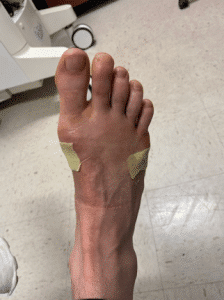
After Surgery

Before Surgery
Do you have a bunion? Have you heard the horror stories about getting a bunion fixed?
Dr. Haynes has spent many long hours training from some of the best minimally invasive surgeons in the country. These techniques specialize in small keyhole incisions that typically don’t require any sutures. Dr. Haynes removes the bump and makes a couple of small cuts in the bone which are used to correct the bunion. No metal or hardware is used. This helps simplify the healing process. Because very little of the underlying soft tissue is disrupted the bone can heal and no hardware is needed, as the soft tissue and external bandaging prevents the bone from moving. This type of procedure can be done on numerous foot pathologies such as ball of foot pain or metatarsalgia, Morton’s neuroma, bunions, hammertoes, prominent bony spurs, plantar fasciitis, Tailor’s bunion’s.
Dr. Haynes uses a drill that has a small bur attached. This bur works at very low speeds but has a high torque. This means that it won’t tangle up in soft tissue and only cuts very hard surfaces when pressure is applied. With this special instrument bone can be cut under the skin without making an incision. Instead, we make more of a large needle stick.
Even better, we can do these procedures in the office. No anesthesia, no hardware, no expensive hospital fees, and best of all you can still walk on the foot right after surgery. By keeping the skin intact and by not disrupting a lot of the soft tissue pain is very minimal and most patients do not take anything more than Tylenol or Ibuprofen.
Here is an example of a Tailors bunion done in office. Patient has pain the day of surgery but never took anything more than ibuprofen and walking in a fracture boot when he left the clinic.
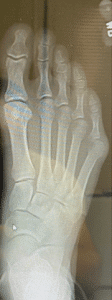
Before

After
This patient went on to heal uneventfully and has no pain or prominence to the outside of his foot. Notice the 5th toe is also straight and more biomechanically aligned.
Here is another great use of the procedure. This patient is a diabetic with only one functioning kidney. He has had a kidney transplant before. He is a diabetic and well controlled. He has had this right foot ulcer below for over four years. He had the end of the foot amputated 10-12 years prior. He had undergone surgery with flaps, lengthening of his Achilles tendon, time spent with wound care clinics, casts, etc. All would heel the wound only temporarily. This patient underwent minimally invasive surgery where we cut the bones just above the ulcer and allowed him to walk in a post op shoe. The goal was that when he walked it would cause the bones to elevate. They can’t elevate too much as the surrounding soft tissue is still intact. However, if we could get the bones to elevate some it would greatly reduce the forces applied to the bottom of the foot causing the ulcer. Needless to say that prior to the surgery he developed an infection in the left foot which caused him to have the 2nd and 3rd toes removed on the left foot. This also caused him to go on dialysis which he was then told he would need another kidney transplant. However, to get on the transplant list he would need to have the ulcer on the right all healed to prevent potential infection into the newly transplanted kidney.

Ulcer 6 weeks after surgery
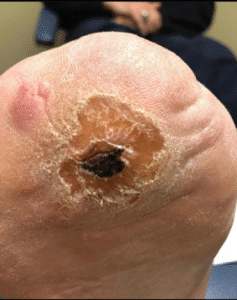
Ulcer four weeks after surgery
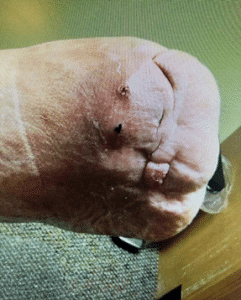
Small incisions from surgery
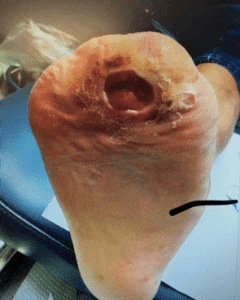
ulcer before surgery
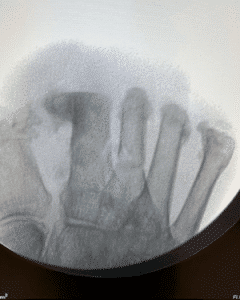
x-rays before surgery
At six weeks a four-year old ulcer was completely healed and at over 6 months the patient remains clinically healed.
The advantages of these types or surgery are minimal pain, less risk of infection, minimal incisions, walk immediately, no narcotics, no hardware, and largely decreased costs as the hospital fees and anesthesia fees are taken out of the costs. In fact, if you have been told before that you are not a surgical candidate either due to age, use of blood thinners, or other reasons, this may be a procedure for you.
Traditional surgery is on it’s way out, in fact your insurance company would prefer minimally invasive as the costs are lower, the risks are lower and in our opinion patient satisfaction is higher for a number of reasons. Healthcare is changing. Insurances are paying less to doctors and making you pay more for procedures that are done in the hospital when they can easily be done in surgery center or a doctor’s office.
If you are interested in seeing if your foot problems can be fixed without surgery or if they need surgery and minimally invasive is a procedure you’re interested in call us today at (503) 668-5210 or email us at frontoffice@elitefaor.com.

